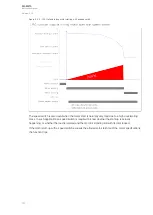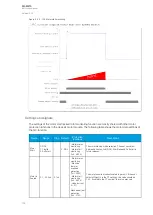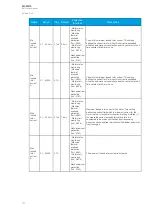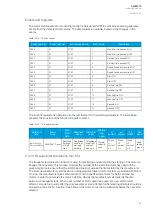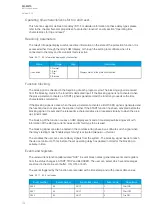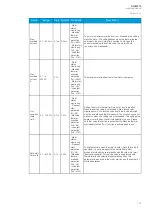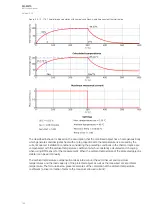
Table. 5.3.10 - 78. Register content.
Date and time
Event code
Inhibit time on
Time since last
start
Start count
dd.mm.yyyy
hh:mm:ss.mss
3584-3589
Descr.
If on, it shows how long the
inhibit is active
Time elapsed from last
starting
Starts used at the
triggering moment
5.3.11 Non-directional undercurrent protection (I<; 37)
The non-directional undercurrent function is used for monitoring motor loading especially in conveyor-
type of applications. A sudden loss in the motor load indicates problems in the actual load rather than
in the motor itself. In a conveyor application this may indicate a broken belt and the motor should be
turned off immediately to avoid further problems. The cause may also be a mechanical breakdown of
the apparatus the motor uses. In some cases this undercurrent function's output may be also used in
an automation system to indicate that the device has finished its work load and is ready for a next task.
In order to operate this function requires
motor running status signal to be active. Motor running is
connected internally from
Motor status monitoring function. The operation of undercurrent protection is
blocked when the motor is not running.
The non-directional undercurrent function is used for instant and time-delayed undercurrent protection.
The operating decisions are based on phase current magnitude, constantly measured by the
function. The available phase current magnitudes are equal to RMS values. The blocking signal and the
setting group selection control the operating characteristics of the function during normal operation,
i.e. the user or user-defined logic can change function parameters while the function is running.
The outputs of the function are the START, TRIP and BLOCKED signals. The undercurrent function
uses a total of eight (8) separate setting groups which can be selected from one common source.
The function can operate on instant or time-delayed mode. In the time-delayed mode the operation can
be set to operate on definite time (DT) delay.
The inputs for the function are the following:
• setting parameters
• digital inputs and logic signals
• measured and pre-processed current magnitudes.
The function outputs the START, TRIP and BLOCKED signals which can be used for direct I/O
controlling and user logic programming. The function generates general time-stamped ON/OFF events
to the common event buffer from each of the three (3) output signals. In the instant operating mode the
function outputs START and TRIP events simultaneously with an equivalent time stamp. The time stamp
resolution is 1 ms. The function also provides a resettable cumulative counter for the START, TRIP and
BLOCKED events.
The following figure presents a simplified function block diagram of the undercurrent function.
A
AQ
Q-M210
-M210
Instruction manual
Version: 2.04
150


